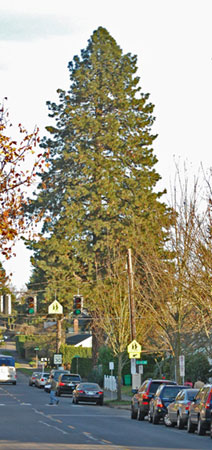By Doug Decker | Historian

seedling when it survived an
1885 fire and was replanted at 29th Avenue and Fremont Street. It rates a visit while your child – and/or you – pursue Doug Decker’s Home History on trees. Photo by Doug Decker
Editor’s note: Historian-turned-teacher Doug Decker offers a new chapter each Monday in neighborhood history for students continuing their schooling at home. Visit Home History School at AlamedaHistory.org for archived and new lesson plans. One May Monday, he offered the history lesson below related to the area’s oldest living residents: trees.
Portland has more than 300 Heritage Trees, which have a special designation because of their unique size, age or historical significance. Northeast Portland neighborhoods have a great cluster of Heritage Trees north of Broadway Street, east of Interstate Avenue, south of Killingsworth Street and west of 33rd Avenue.
A bunch are probably within walking distance of you, so it’s time to meet some of them, especially one of our favorites, the Pearson Pine at 29th Avenue and Fremont Street.
Long ago, before neighborhoods existed on these lands, there were forests of Douglas-fir, hemlock, western red cedar, alder, maple and even pine that blanketed these lands. Gradually many of those trees were cut either for lumber or to make room for the farm fields and orchards that followed.
And then 100 years ago, when most of our neighborhoods were just taking shape, the people who built our streets and houses figured the new homeowners would want tree-lined streets. But they knew it would take a while, so they planted many different kinds. Some of those have gotten old and big.
One such tree is the big Ponderosa pine at the southwest corner of 29th Avenue and Alameda Street. A few years back, I nominated that tree to Portland’s heritage tree list after learning its story, which goes something like this:
Back in about 1885, there was a forest fire that burned through this area and killed many trees, young and old, but left some trees untouched. After the fire, a local farmer named Samuel Pearson – who used to run a dairy that stood about where Alameda School is today – found one of these young seedlings that survived the fire: a Ponderosa pine tree, which is much more common in eastern Oregon.
Because it was different than most of the other trees around here, Samuel knew it would always stand out, so he planted it in a special place to mark the corner of his property. Today, it’s a giant, visible from all around.
His dairy and cows are long gone, but Samuel was right: that tree sure stands out. So do all of the other Heritage Trees in the neighborhood.
For additional research sources on Heritage Trees, click here.
Heritage Trees activity suggestions & novelties
- Have a look at the trees around your house. Can you tell which one is the tallest or the oldest? Ask around your family or your neighbors to see if you can learn when your trees were planted. (One family who lived in our house planted a live Christmas tree in front of our house back in the 1970s and it grew tall before it had to be removed).
- How about your neighborhood? Can you tell which trees are the tallest or the oldest? Have they been trimmed to make way for the power lines? Can you see old scars where branches may have broken off in the snow, ice or wind?
- Here’s something that might be fun. See if you can identify the species of trees you have around your house or on your block. There are many clues to look at when you identify your tree: the shape of its leaves (or needles), the texture of its bark, its shape and size, its flowers, cones, seeds or fruit. Check out this helpful tree identification tool.
- Which is your favorite tree in your neighborhood? Why? How have you seen it change? Draw a picture of your favorite tree.
- Draw a map that shows the different trees around your house or on your block and what kind they are.
- Go visit the Pearson Pine and stand underneath its branches. Did you know this is one of the oldest living things in our area? What stories do you think it could tell?
- Did you know trees all have different sounds as the winds blow through? Next windy day, listen carefully.
- Here’s a link to the map of some local Heritage Trees. Choose a few to visit and find your favorite.
Doug Decker initiated his blog AlamedaHistory.org in 2007 to collect and share knowledge about the life of old houses, buildings and neighborhoods in northeast Portland. His basic notion is that insight to the past adds new meaning to the present.